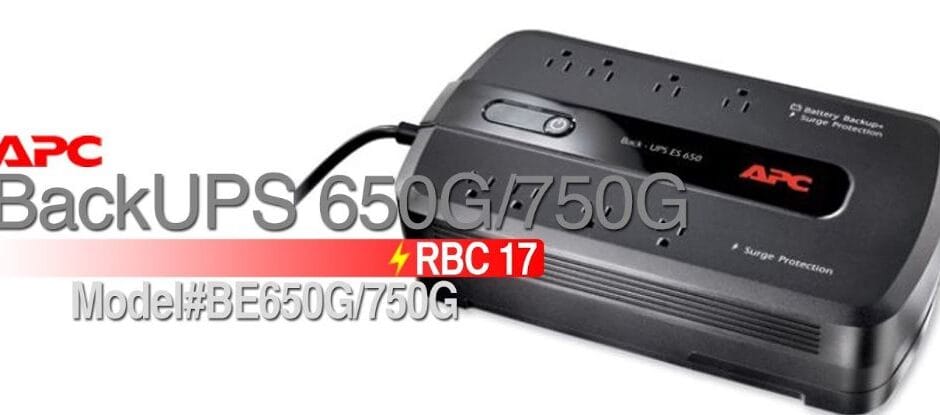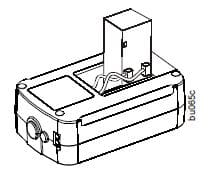
APC NS600 Back-UPS

Inventory

Safety and General Information
Inspect the package contents upon receipt. Notify the carrier and dealer if there is any damage. Read the Safety Guide supplied with this unit before installing the UPS.
- This UPS is intended for indoor use only.
- Do not operate this UPS in direct sunlight, in contact with fluids, or where there is excessive dust or humidity.
- Be sure the air vents on the UPS are not blocked. Allow adequate space for proper ventilation.
- The battery typically lasts for three to five years. Environmental factors impact battery life. Elevated ambient temperatures, poor quality AC power, and frequent short duration discharges will shorten battery life.
- Connect the UPS power cable directly to a wall outlet. Do not use surge protectors or extension cords.
Specifications
Input | Voltage | 120 Vac Nominal |
| Frequency | 47 – 63 Hz | |
| Brownout Transfers | 92 Vac Typical | |
| Over-voltage Transfer | 139 Vac Typical | |
Output | UPS Capacity (4 battery backup outlets) | BN600G: 600 VA, 360 W |
| Total Amperage (all outlets) | 12 A (including UPS output) | |
| Voltage – On Battery | 115 Vac ± 8% | |
| Frequency – On Battery | 50 / 60 Hz + 1 | |
| Transfer Time | 6 ms Typical, 10 ms maximum | |
| Protection and Filtering | AC Surge Protection | Full time, 340 Joules |
| EMI/RFI Filter | Full time | |
| AC Input | Resettable circuit breaker | |
Battery | Type | Sealed, maintenance-free, lead acid BN600G: RBC110 |
| Typical Recharge Time | 24 hours | |
| Average Life | 3 – 5 years depending on the number of discharge cycles and environmental temperature | |
Physical | Net Weight | Replacement battery cartridge BN600G: 12 lb (5.5 kg) |
| Dimensions Length x Width x Height | 12 in x 7 in x 3 in 30 cm x 18 cm x 9 cm | |
| Operating Temperature | 32º F to 104º F (0º C to 40º C) | |
| Storage Temperature | 5º F to 113º F (–15º C to 45º C) | |
| Operating Relative Humidity | 0 to 95% non-condensing humidity | |
| Operating Elevation | 0 to 10,000 ft (0 to 3000 m) | |
EMC Compliance | This device complies with part 68 and part 15 of the FCC rules. Operation is subject to the following two conditions: (1) This device may not cause harmful interference, and (2) This device must accept any interference received, including interference that may cause undesired operation. Locate the label on the bottom of this device that contains, among other information, the FCC registration number and ringer equivalence number (REN) for this device. If requested, this information must be provided to the telephone company. If you experience trouble with this equipment, you disconnect it from the network until the problem has been corrected or until you are sure that the equipment is not malfunctioning. The ringer equivalence number (REN) is used to determine how many devices can be connected to your telephone line. In most areas, the sum of the RENs of all devices on any one line should not exceed five (5.0). If too many devices are attached, they may not ring properly. | |
Connect the Battery
The Back-UPS is shipped with one battery cable disconnected. Remove the “Stop! Connect the Battery” label that covers the outlets. Prior to connecting any equipment to the unit, connect the battery cable to the unused battery terminal. It is normal for small sparks to be seen when the battery cable is connected to the battery terminal.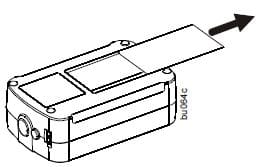
- Press the battery compartment cover release tab located on the rear side of the unit. Slide the battery cover off.

- Connect the battery cable securely to the battery terminal.

- Reinstall the battery compartment cover. Be sure that the release tab locks into place.
Wall Mount Installation
- Horizontal installation, use 2 screws 7.3″ (186.3 mm) apart.
- Vertical installation, use 2 screws 5.4″ (137.2 mm) apart.
- Allow 5/16” (8 mm), of the screw to protrude from the wall.
Replace Battery
Deliver the used battery to a recycling facility. Replace the used battery with an APC by Schneider Electric approved battery. Replacement batteries can be ordered through the APC by Schneider Electric Web site, www.apc.com. Battery replacement part for Back-UPS BN600G is APCRBC110.
Connect Equipment
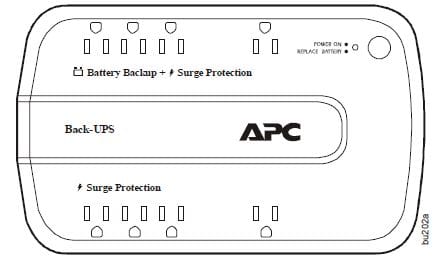
Battery Backup + Surge Protection Outlets
Battery backup outlets provide protection to connected equipment when the Back-UPS is turned on and connected to AC power. Battery backup outlets receive power from the Back-UPS for a limited period of time when a power outage, or brownout condition occurs. Battery backup outlets provide protection from power surges or spikes. Connect a computer, monitor and other peripheral devices to the outlets.
Surge Protection Outlets
Surge protection outlets provide protection to connected equipment when the Back-UPS is connected to AC power, and is switched on or off. Surge protection outlets provide protection from power surges or spikes. Connect a printer, scanner or other peripheral devices that do not need to remain on during power outages, or AC problems to the surge protection outlets.
Connect Network
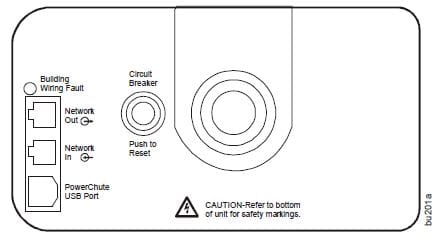
The Back-UPS protects equipment connected to a 10/100 Base-T ethernet, from power surges when connected through the Back-UPS dataline protection jacks.
PowerChute™ Personal Edition Software
Overview
- Use PowerChute Personal Edition software to configure the UPS settings. Protect your computer and other equipment during a power outage. During a power outage, PowerChute will save any open files on your computer and safely shut it down. When power is restored, it will restart the computer.
- Configure the UPS to use features such as power-saving outlets, shutdown configuration, and alarms.
- Monitor the UPS for power usage and power events.
Note: PowerChute is only compatible with a Windows operating system. If you are using a Mac OSX, use the native shutdown feature to protect your system. See the documentation provided with your computer.
Installation
- Use a USB cable to connect the Data port on the rear panel of the UPS to the USB port on your computer.
- If the Back-UPS came with a PowerChute CD, insert the CD into your computer and follow the on-screen instructions
- If the Back-UPS did not come with a PowerChute CD, go to www.apc.com and download the software free of charge.
Turn On the Back-UPS
Press the POWER ON button located on the top of the Back-UPS. The Power On/ Replace Battery LED will illuminate and a single short beep will be audible to indicate that the Back-UPS is providing protection for connected equipment. The Back-UPS battery charges fully during the first 16 hours while connected to AC power. The Back-UPS battery will charge while the Back-UPS is switched on or off
and is connected to AC power. Do not expect full battery run capability during the initial charge time.
If the red Building Wiring Fault LED located on the side of the Back-UPS illuminates, do not operate the Back-UPS. Have a qualified electrician correct the building wiring fault.
Warranty
The standard warranty is three (3) years from the date of purchase. Schneider Electric IT (SEIT) standard procedure is to replace the original unit with a factory reconditioned unit. Customers who must have the original unit back due to the assignment of asset tags and set depreciation schedules must declare such a need at first contact with an Schneider Electric IT (SEIT) Technical Support representative. SEIT will ship the replacement unit once the defective unit has been received by the repair department, or cross ship upon the receipt of a valid credit card number. The customer pays for shipping the unit to SEIT. SEIT pays ground freight transportation costs to ship the replacement unit to the customer.
Status Indicators
| Status | LED Indicator | Audible Indicator On | Audible Indicator Terminates |
| Power On The Back-UPS is supplying AC power to connected equipment. | The green LED illuminates. | None | N/A |
| On Battery Back-UPS supplying battery power to battery backup outlets. | The green LED illuminates. The LED is not illuminated during the beeps. | Back-UPS beeps 4 times every 30 seconds. | Beeping stops when AC power is restored or the Back-UPS is turned off. |
| Low Battery warning The Back-UPS is supplying battery power to the battery backup outlets and the battery is near a total discharge state. | The green LED illuminates with rapid green flashes. | The Back-UPS emits rapid beeping, every 1/2 second. | Beeping stops when AC power is restored or the Back-UPS is turned off. |
| Replace Battery • The battery is disconnected. • The battery needs to be charged, or replaced. | • Replace Battery LED flashes. • Replace Battery and Power On LEDs flash alternately. | Constant tone Constant tone | Back-UPS is turned off. |
| Overload Shutdown While on battery power an overload condition has occurred in one or more of the battery backup outlets while the Back-UPS is operating on battery power. | None | Constant tone | Back-UPS is turned off. |
| Sleep Mode While on battery power the battery is completely discharged. The Back-UPS will “awaken” once AC power is restored. | None | The Back-UPS beeps once every four seconds. | The beeping stops when: • AC power is restored • If AC power is not restored within 32 seconds • The Back-UPS is turned off |
| Building Wiring Fault The building wiring presents a shock hazard that must be corrected by a qualified electrical. | Building Wiring Fault LED illuminates red | None | The Back-UPS is unplugged from the wall outlet or is plugged into an improperly wired outlet. |
Troubleshooting
| Problem and Possible Cause | Solution |
| The Back-UPS will not turn on | |
| The Back-UPS has not been turned on. | Press the POW ER ON button. |
| The Back-UPS is not connected to AC power, there is no AC power available at the wall outlet, or the AC power is experiencing a brownout or over voltage condition. | Make sure the power cord is securely connected to the wall outlet, and that there is AC power available at the wall outlet.Where applicable, check that the wall outlet is switched on. |
| The battery is not connected. | Connect the battery. Refer to “Connect the Battery” on page 1 of this manual. In the event that the Back-UPS receives no AC power and the battery is connected, a cold-start can be initiated. Press and hold the Power On button until the Back-UPS emits two beeps. |
| The Back-UPS is on, the Replace Battery LED flashes and the unit emits a constant tone | |
| The battery is disconnected. | Refer to the “Connect the Battery” on page 1. |
| Connected equipment loses power | |
| A Back-UPS overload condition has occurred. | Remove all nonessential equipment connected to the outlets. One at a time reconnect equipment to the Back-UPS. Charge the battery for 24 hours to make sure it is fully charged. If the overload condition still occurs, replace the battery. |
| The Back-UPS battery is completely discharged. | Connect the Back-UPS to AC power and allow the battery to recharge for eight hours. |
| PowerChute software has performed a shutdown due to a power failure. | This is normal Back-UPS operation. |
| Connected equipment does not accept the step-approximated sine waveform from the Back-UPS. | The output waveform is intended for computers and peripheral devices. It is not intended for use with motor driven equipment. |
| The Back-UPS may require service. | Contact SEIT Technical Support for more in depth troubleshooting. |
| The Power On LED is illuminated and the Back-UPS beeps 4 times every 30 seconds | |
| The Back-UPS is operating on battery power. | The Back-UPS is operating normally on battery power. At this point the user should save all open files, and shutdown the computer. When AC power is restored the battery will recharge. |
| The Power On LED flashes once every second while the Back-UPS beeps once every second | |
| The Back-UPS battery has approximately two minutes of remaining runtime. | The Back-UPS battery is near a total discharge state. At this point the user should save all open files, and shutdown the computer. When AC power is restored the battery will recharge. |
| The Building Wiring Fault LED illuminates | |
| The building wiring presents a shock hazard that must be corrected by a qualified electrical. | Do not operate the Back-UPS. Call a qualified electrician to correct the building wiring fault. |
| The Back-UPS has an inadequate battery runtime | |
| The battery is not fully charged. The battery is near the end of useful life and should be replaced. | Leave the Back-UPS connected to AC power for 16 hours while the battery charges to full capacity. As a battery ages, the runtime capability decreases. Contact APC by Schneider Electric at the website www.apc.com to order replacement batteries. |
| The connection from the Back-UPS to the internet is lost during a power outage | |
| The modem has lost power. | Connect the modem cable into one of the Battery Backup + Surge Protection outlets. |
Voltage Sensitivity Adjustment (optional)
The Back-UPS detects and reacts to line voltage distortions by transferring to battery backup power to protect connected equipment. In situations where either the Back-UPS or the connected equipment is too sensitive for the input voltage level it is necessary to adjust the transfer voltage.
- Connect the Back-UPS to a wall outlet. The Back-UPS will be in Standby mode, no indicators will be illuminated.
- Press and hold the ON/OFF button for 10 seconds. The OnLine LED will illuminate alternately green-amber-red, to indicate that the Back-UPS is in Program mode.
- The Power On/Replace Battery LED will flash either green, amber, or red to indicate the current sensitivity level. Refer to the table for an explanation of the transfer voltage sensitivity levels.
- To select LOW sensitivity, press and hold the ON/OFF button until the LED flashes green.
- To select MEDIUM sensitivity, press and hold the ON/OFF button until the LED flashes red.
- To select HIGH sensitivity, press and hold the ON/OFF button until the LED flashes amber.
- To exit Program mode wait five seconds and all LED indicators will extinguish. Program mode is no longer active.
| LED Flashes | Sensitivity Setting | Input Voltage Range (AC Operation) | Recommended Use |
| Green | LOW | 88 Vac to 142 Vac | Use this setting with equipment that is less sensitive to fluctuations in voltage or waveform distortions. |
| Red | MEDIUM | 92 Vac to 139 Vac | Factory default setting. Use this setting under normal conditions. |
| Amber | HIGH | 96 Vac to 136 Vac | Use this setting when connected equipment is sensitive to voltage and waveform fluctuations. |
Service
If the unit requires service, do not return it to the dealer.
Follow these steps:
- Review the Troubleshooting section of the manual to eliminate common problems.
- If the problem persists, contact Schneider Electric IT (SEIT) Customer Support through the APC by Schneider Electric Web site, www.apc.com.
- Note the model number and serial number and the date of purchase. The model and serial numbers are located on the rear panel of the unit and are available through the LCD display on select models.
- Call SEIT Customer Support and a technician will attempt to solve the problem over the phone. If this is not possible, the technician will issue a Returned Material Authorization Number (RMA#).
- If the unit is under warranty, the repairs are free.
- Service procedures and returns may vary internationally. Refer to the APC by Schneider Electric Web site for country specific instructions.
- Pack the unit in the original packaging whenever possible to avoid damage in transit. Never use foam beads for packaging. Damage sustained in transit is not covered under warranty.
- Always DISCONNECT THE UPS BATTERIES before shipping. The United States Department of Transportation (DOT), and the International Air Transport Association (IATA) regulations require that UPS batteries be disconnected before shipping. The internal batteries may remain in the UPS.
- Write the RMA# provided by Customer Support on the outside of the package.
- Return the unit by insured, pre-paid carrier to the address provided by Customer Support
APC by Schneider Electric IT Customer Support Worldwide
For country specific customer support, go to the APC by Schneider Electric Web site, www.apc.com.
For more manuals about APC, visit ManualsLibraryy
APC NS600 Back-UPS-FAQs
Can APC backup work without a battery?
Technically, yes, an APC UPS can power on without a battery, but it will only function as a surge protector and won’t provide backup power during outages.
How do I charge the APC Back-UPS 600?
To charge the Back-UPS 600, connect it to AC power. The battery will fully charge within 24 hours, whether the UPS is switched on or off.
How long does an APC UPS battery backup last?
The lifespan of a UPS battery typically ranges from 3-5 years for VRLA batteries and 8-10 years for Lithium-Ion batteries under optimal conditions.
Should I turn off the APC UPS when not in use?
Yes, turning off the UPS when not in use helps prolong the battery life, reducing the frequency of replacements.
What happens if the UPS battery dies?
If the battery dies, the UPS will no longer provide backup power, leading to potential system failures. Battery replacement is crucial for continued functionality.
What is the maximum backup time for a UPS?
The backup time varies based on the UPS size and load. Small units can last up to 10 minutes, while larger units can provide power for up to an hour.
Why is my APC UPS beeping continuously?
Continuous beeping may indicate:
1.The UPS is running on battery power.
2.The UPS capacity is overloaded.
3.The battery charge is low.
How do I check my APC battery?
To perform a self-test:
1.Press the Enter button on the UPS display.
2.Navigate to “tSt” using the Down button and press Enter.
3.The UPS will run a self-test, showing the results after completion.
How does APC work?
APC UPS provides continuous power during outages by switching to battery backup and protects devices from power surges, ensuring uninterrupted operation.
Which UPS can last for 3 hours?
Models like the APC Smart-UPS 1500VA and CyberPower CP1500PFCLCD are reliable options for a 3-hour backup under moderate loads.

